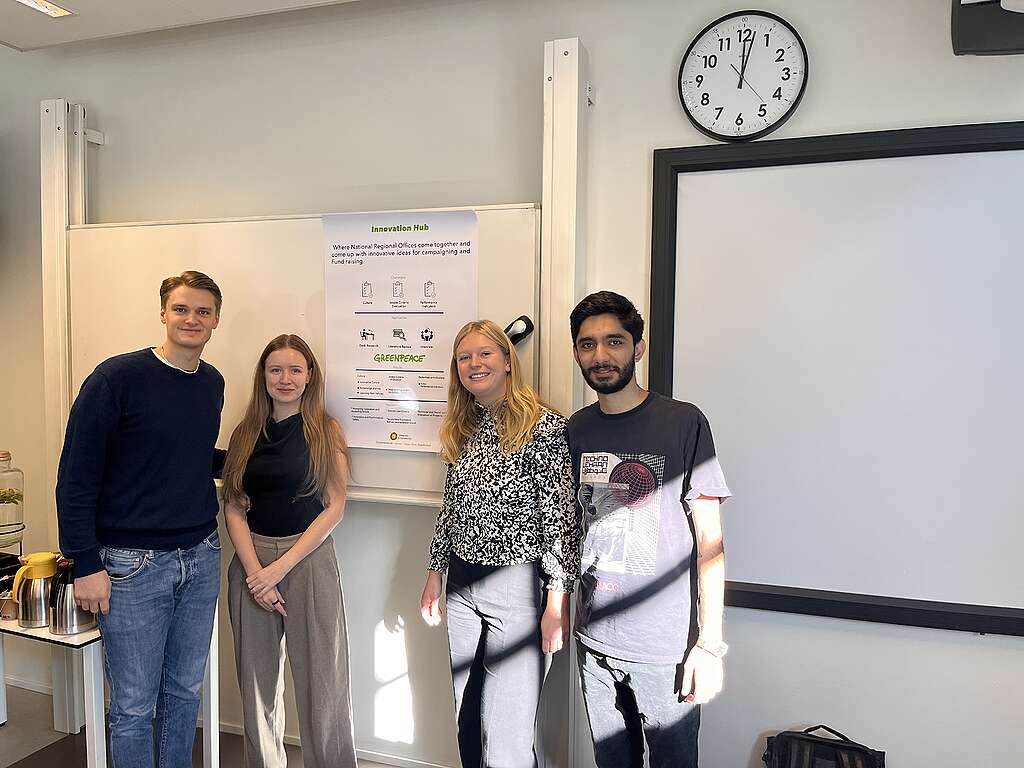It all began with a shared vision: to empower Greenpeace’s Innovation Hub to spark meaningful, lasting change. But how did this shared journey of creativity, challenge and transformation come to life?
Greenpeace, looking for fresh perspectives and external support, joined the Master Challenge platform and became part of a university consulting program in partnership with the Utrecht University in the Netherlands. That’s where we came in – four students from diverse backgrounds, cultures and experiences brought together through our intrapreneurship course and united by a common purpose: to work on a project that truly mattered.
Over the course of eight weeks, our team dove into the world of environmental innovation, offering strategic insights and collaborating closely with the team behind Innovation Hub. But this wasn’t just a class project – it was a journey filled with inspiration, unexpected challenges and powerful moments that reminded us just how vital innovation is to the future of environmental activism.
Four students joined Greenpeace to bring innovation into environmental activism

When we first connected with Greenpeace, we were immediately drawn to the Innovation Hub’s mission. It was something that bridged our 2 areas of interest – technology innovation and care for the planet. The idea of working on a framework for selecting and assessing projects within a global campaigning network was thrilling. On the first meeting, we got introduced to the Hub and how it serves Greenpeace’s Technology Vision.
As technology develops and the world gets more digitised by the day, Greenpeace is laying the foundations to still remain impactful by implementing its Technology Vision within the organisation. Built around a 3-horizons framework, Greenpeace’s Tech Vision sets the guiding star to digitally transform the entire network, from running campaigns and collecting donations, to collaborating effectively and operating ships. The purpose of the Innovation Hub within this strategic program is simple – to allow for innovative ideas to come to life, help reach more people and raise awareness and funds to fight for a sustainable future.
How do we define success?
No meaningful work is ever without its hurdles. Early on, we realised that defining success for Greenpeace’s new projects was complex. Unlike the corporate world, where key performance indicators (KPIs) are often tied to market share, Greenpeace operates in a dynamic landscape where impact is measured in influence, awareness, and mindset shifts. Our challenge was; how do we ensure that groundbreaking ideas get the support they need?
To answer these questions, we followed this structure: first, we decided on the methodology of how we will go about this. Knowing that there were many different parts that needed to be addressed. After careful examination, we decided that a thorough literature research will bring the most advantages, combined with interviews with the people behind the Innovation Hub. We explored key academic frameworks on non-profit innovation, project evaluation, and knowledge-sharing to ensure our approach was grounded in research. Further, innovation thrives on iteration. We researched how to learn from both successes and failures, ensuring that knowledge is captured and applied to future projects.
To better understand the role and impact of the Innovation Hub, we designed a set of interview questions aimed at exploring its purpose, strengths, challenges, and overall contribution to broader goals. These questions also sought to uncover individual perspectives on how the hub operates, what success looks like, and how its learnings can be applied. The goal was to gather insights that could help evaluate the hub’s effectiveness and shape its future direction. By capturing diverse viewpoints, we aimed to create a well-rounded understanding that supports continuous improvement and strategic alignment.
The challenge along the way – expectation vs reality
One of the challenges we found was the one of internal alignment. Greenpeace is a global network of independent organisations with passionate individuals who bring diverse perspectives. The expectations of every person differed a little bit, and we needed to make sure that while innovation should not be slowed down with bureaucracy, we still needed to provide and establish some general frameworks. We also quickly figured that the time that each person can spend on this project is also highly limited from Greenpeace’s side, so we had to keep in mind this while also assessing the adjustments and recommendations.
Influencing change with the outcome
After 8 weeks of almost daily work, we were able to present our results both at the university and to the leaders of the Innovation Hub project. We managed to influence change along two main areas. We worked on quantitative evaluations – this meant adjusting the scoring assessment (as displayed above) and adding subcategories based on academic research for a more accurate evaluation of ideas. Further, as innovation comes with big challenges in terms of human capital, we worked a lot on learning about innovation change within the organisation. This means learning about how to introduce change, psychological safety and other factors, things that are to be implemented in the long term.
We were awarded first place in terms of most innovative and applicable project out of our class, which was amazing after the many hours of hard work. We hope that our work brought practical improvements and that Greenpeace will continue to develop its Innovation Hub and make it a great success!
We wonder – what do you think of this project? Which parts of your organisation do you think could benefit from this? Let us know in the comments below!
Jonas Wernstedt, Tímea Szipková, Sara Verhoef and Sepehrdad Jam are students in Business Development & Entrepreneurship at Utrecht University in the Netherlands.
Guest authors work with Greenpeace International to share their personal experiences and perspectives and are responsible for their own content.
Source link
Tímea Szipková www.greenpeace.org

